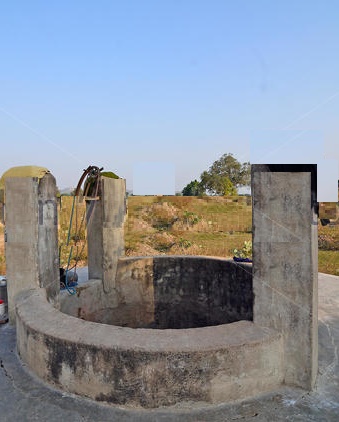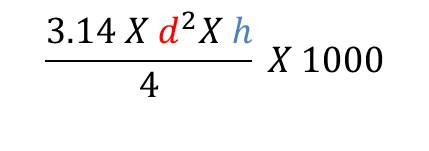
Steps in well disinfection:
1. Find out the volume of water present in the well using the given formula liters
liters
2.Find the amount of bleaching powder required for disinfection, Using ‘Horrock’s Apparatus’
3. Dissolve the required amount of bleaching powder in water
4. Delivery of the chlorine solution into the well
5. Allow a “Contact period” – one hour
6. Orthotolidine Arsenite (OTA)test, to test if the ‘free’ residual chlorine is > 0.5 mg/L
1. Find out the volume of water present in the well
Measure the depth of the water column
= ‘h’ meters
Measure the diameter of the well
= ‘d’ meters
Substitute ‘h’ and ‘d’ in the following formula:
One cubic meter = 1,000 liters of water
2. Find the Amount of Bleaching Powder Required
Estimate the ‘chlorine demand’ of the well water and then
Calculate the amount of bleaching powder required for the particular well
This is done by using “Horrock’s Apparatus” (consists of 6 white cups and one black cup)
The first cup which develops blue color gives an estimate of the amount of bleaching powder needed to disinfect 455 L of the sample water
Steps in using ‘Horrock’s Apparatus’ for calculating the dose of the bleaching powder are explained in another blog: http://www.ihatepsm.com/blog/horrock%E2%80%99s-apparatus
3. Dissolve the Calculated Amount of Bleaching Powder in Water
The calculated amount is drawn and placed in a bucket (not > 100gm per bucket)
Make it into a thin paste
Add more water till the bucket is nearly ¾ full
The contents are stirred well
Allow to sediment for 5 – 10 min
Lime settles down
The supernatant solution is the chlorine solution
This supernatant chlorine solution is transferred to another bucket
The chalk or lime which settles at the bottom is discarded
DO NOT POUR the SEDIMENT into the well, this is lime which will increase the hardness of water
4. Delivery of the Chlorine Solution into the Well
The bucket containing the chlorine solution is lowered some distance below the water surface
Then the well water is agitated by moving the bucket violently vertically and laterally
This is repeated several times to ensure thorough mixing of the chlorine solution into all of the well water
5. Allow a Contact Period between the Chlorine and Water
Contact period of one hour is allowed before anyone is permitted to draw water from the well
6. Perform Orthotolidine Arsenite (OTA)Test
Orthotolidine Arsenite Test is then performed at the end of one hour contact period
This is done to check the level of free residual chlorine
If the free residual chlorine is < 0.5 mg/L, the entire procedure is repeated before any water is drawn
Hence wells are best disinfected at night after the day’s draw off
During epidemics of cholera, wells should be disinfected every day
